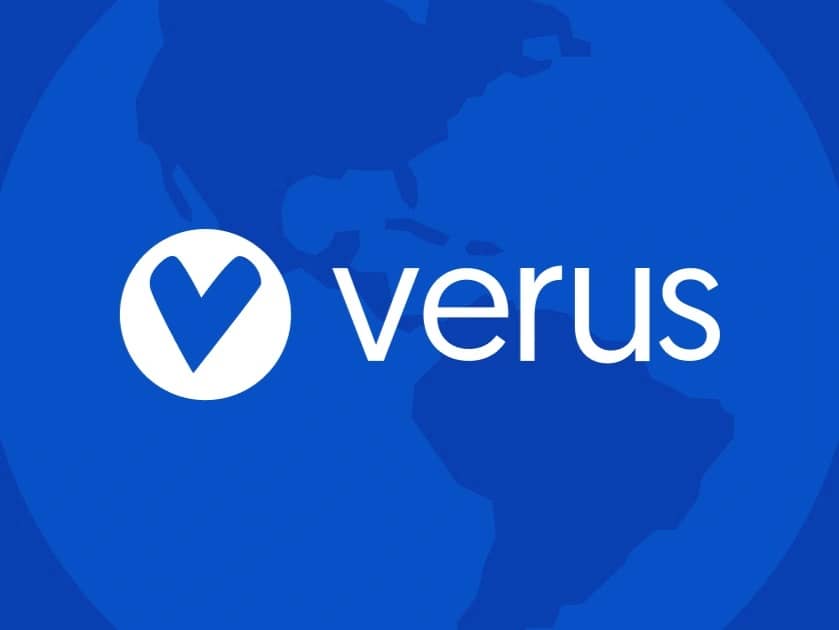订阅 wiki
Share wiki
Bookmark
Verus
Verus
Verus 是一个去中心化的开源区块链协议,它利用工作量证明和权益证明共识。它旨在为开发产品、服务和系统提供免租金的工具。它旨在通过协议原生功能实现自主身份、多币种DeFi和链间功能,从而消除对智能合约的依赖。[1]
概述
Verus 于 2018 年公平启动,是一个开源的去中心化区块链协议,它结合使用工作量证明和权益证明共识,称为“权力证明”。它旨在通过提供公共区块链即服务 (PBaaS) 来创建可互操作的区块链、代币和去中心化金融 (DeFi)应用程序,从而优先考虑可扩展性、安全性和去中心化。
该协议结合了用于自主数字身份的 VerusID,并支持安全、低费用的跨链交易。Verus 被设计为一个多链生态系统,以实现去中心化、可扩展和可定制的区块链用例。[1] [2] [3] [4]

产品
PBaaS 链
Verus 旨在提供优先考虑可扩展性、互操作性和可访问性的区块链解决方案。其公共区块链即服务 (PBaaS) 框架支持创建可定制的区块链,这些区块链具有多币种功能、去中心化金融 (DeFi)、自主身份 (VerusID) 和基于 zk-SNARK 的隐私等功能。
这些区块链旨在与 Verus 网络集成,支持跨链交易,并采用混合工作量证明和权益证明共识来抵抗 51% 的哈希攻击。Verus 促进代币创建、流动性池、部分准备金货币和众筹启动,并具有管理参与和退款的机制。其多链生态系统的结构旨在支持可互操作的公共和私有区块链,旨在确保无缝连接和去中心化桥接。[5]
货币发行
Verus 允许创建无需编码的代币。它支持由多个储备支持的篮子货币,以及具有固定或可调整供应量的简单代币货币。Verus-以太坊桥支持与以太坊之间的非托管转移。去中心化众筹机制旨在通过设置参与级别、提供退款和提供启动前折扣来促进代币启动。[6]
VerusID
VerusID 是 Verus 协议区块链上的去中心化自主身份系统。它使用户无需编程技能即可访问 Web3 应用程序、管理资产、发送私人消息和安全地存储数据。VerusID 用作个人或企业标识符,支持交易、安全通信和资产管理。功能包括非托管撤销/恢复、多重签名钱包和隐私选项。
顶级 VerusID 的价格为 100 VRSC,并提供推荐折扣。费用用于矿工、质押者和持续开发。
顶级 VerusID 的价格为 100 VRSC,并提供推荐折扣。只有这些 ID 可用于区块链或货币创建。对于所有其他用例,可以使用子 ID,其最低成本为 0.02 $VRSC。这些费用分配给矿工和质押者。[7] [12]
VerusPay
VerusPay 旨在促进基于区块链的发票创建和支付处理。其 v3 版本引入了标准化发票格式,支持 PBaaS 区块链交易,并允许通过 QR 码或深度链接共享。[8]
VerusDeFi
VerusDeFi 旨在提供一种低成本、抗 MEV 的去中心化金融解决方案,无需中介。它允许用户转换成和转换出储备支持的货币或在储备之间进行交换,费用范围为 0.025% 到 0.05%。
操作在共识层执行,从而降低智能合约风险。VerusDeFi 采用智能交易,通过将 DeFi 功能直接集成到协议中来增强安全性。[9]
Verus-以太坊桥
Verus-以太坊桥促进 Verus 和以太坊区块链之间的去中心化和安全转移,支持 VRSC、ETH、DAI 和 MKR 之间的转换。它允许用户映射 ERC-20 货币、将资产导出到以太坊以及将 VerusID 标记化为 ERC-721 NFT。
Bridge.vETH 是一种稳定的、支持的跨链货币,旨在通过低费用和抵抗矿工提取价值 (MEV) 风险来简化交易。用户还可以注册 .vETH 子 ID 以与跨链 DeFi 操作进行交互。[11]
代币经济学
VerusCoin ($VRSC)
Verus Coin (VRSC) 是一种注重隐私的加密货币,它利用零知识技术和公共区块链即服务 (PBaaS)。它采用一种称为权力证明的共识机制,该机制结合了 50% 的工作量证明 (PoW) 和 50% 的权益证明 (PoS) 来提高安全性和抵抗 51% 的哈希攻击。
Verus Coin 用于支付、质押、区块链创建、代币创建和 DeFi 储备。该项目在没有首次代币发行 (ICO)或预挖代币的情况下运营,旨在让用户更容易使用区块链技术。[10]
实用性
Verus Coin (VRSC) 是 Verus 区块链的原生加密货币,并支持其生态系统中的各种功能。其主要用途包括:
- 支付: VRSC 促进 Verus 网络上的快速、可扩展和最终交易。
- 质押: VRSC 持有者可以参与质押以赚取奖励,而无需最低金额。
- VerusID 创建: VRSC 用于支付 VerusID 的创建费用,VerusID 被设计为量子抗性加密地址,用于发送和接收资金。
- 区块链和代币创建: VRSC 对于在 Verus 网络中创建可互操作的区块链和代币是必需的。
- DeFi 储备: VRSC 是 Verus 链上货币篮子中的强制性储备。最低金额为篮子 TVL 的 5%。
团队
Verus 由开发人员、顾问和社区成员组成,他们贡献技术专长、设计和运营支持。
- Michael J. Toutonghi: Verus 的首席开发人员,多家公司的创始人,在分布式计算和领导职位方面拥有丰富的经验。微软技术院士和前副总裁。
- Michael F. Toutonghi: 首席 GUI 钱包开发人员,专注于移动和桌面平台上的可用性。
- Lex (Alex) English: 具有软件开发和社区协调经验的开发人员/项目经理。
- Asher Dawes: 专门从事构建自动化和跨平台测试流程的开发人员。
- David Dawes: 在金融技术和平台开发方面拥有丰富经验的开发人员。
- jl777: 在区块链开发和技术咨询方面拥有专业知识的顾问。
- Nicholas Lyons: 具有股票市场、技术投资和战略指导背景的顾问。
- Oink: 社区支持负责人,支持用户参与和技术帮助。
- Max Theyse: 首席设计/社区品牌,专注于设计和区块链驱动的创新。
- Chris Monkins: 具有挖矿软件和社区矿池开发专业知识的软件工程师。
- Rozo: Rozo:营销负责人/会议出场。[4]
发现错误了吗?
